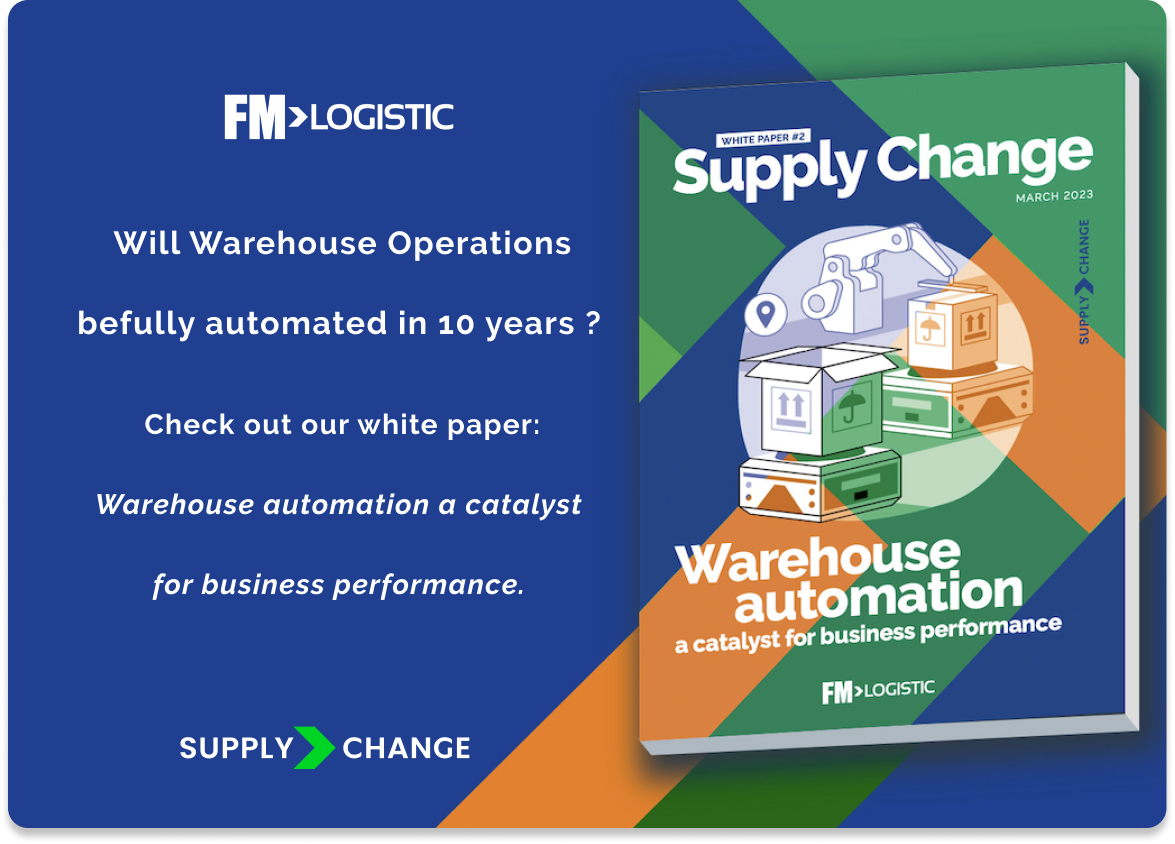FM Logistic study points to full automation of warehouses
Are we heading towards total automation of warehouses and is this the short/medium term future? It seems so, according to a report by the FM Logistic Group. The white paper…
On April 12, 2023

Are we heading towards total automation of warehouses and is this the short/medium term future? It seems so, according to a report by the FM Logistic Group. The white paper…
On April 12, 2023
Are we heading towards total automation of warehouses and is this the short/medium term future? It seems so, according to a report by the FM Logistic Group.
The white paper “Warehouse Automation“, compiled from the responses of more than 100 surveys in three countries, shows a positive outlook towards full automation of the different steps or processes in both e-commerce and B2B warehouses in the next 5-10 years.
The implementation of warehouse automation is on a steady upward trajectory as most organisations, whatever their size, scale and sector, have realised the importance of space optimisation and efficiency of warehouse operations as the key to business success.
Today, partial automation is the most widespread option. According to this FM Logistic survey – conducted among companies in the FMCG, retail and cosmetics and beauty sectors – 80% of companies have adopted partial automation in their e-commerce warehouses and 84% in their B2B warehouses. However, 76% of organisations operating an e-commerce warehouse with partial automation and 45% of those operating a B2B warehouse with partial automation intend to fully automate in the future. Different factors explain this decision.
94% of companies see improved efficiency, accuracy and customer service as the main drivers for change in all types of warehouses. Reducing errors is mentioned by 90% of organisations for e-commerce warehouses, and increased security is noted by 86% of organisations for B2B warehouses.
In addition, warehouse automation is driven by the rapid rise of e-commerce. Innovations, the growing popularity of the supply chain as a service (SCaaS) model, and increasing access to technological advances also catalyse this trend towards full automation.
While most of the organisations surveyed have partially automated e-commerce warehouses, larger organisations appear to be moving down the automation path faster than smaller ones. According to FM Logistic’s survey, 43% of large organisations currently have fully automated e-commerce warehouses, while respectively only 9% of medium-sized and 4% of small organisations have fully automated warehouses.
In the case of B2B warehouses, 30% of large companies have fully automated B2B warehouses, compared to 24% of medium-sized and 6% of small companies.
Many companies surveyed plan to fully automate their warehouses to increase their efficiency in handling large order volumes, product customisations and frequent returns/reverse logistics to meet the needs of a rapidly growing market.
By sector, 100% of companies in the cosmetics and beauty sector plan to fully automate their e-commerce warehouses in the future. This trend is explained by the boom in luxury online sales in recent years.
There is also a real need for automation in terms of staff’s own health and working conditions. “In Europe, more than 45% of workers in the transport and warehousing sector reported back pain and musculoskeletal disorders. Automation can improve or deteriorate ergonomics and working conditions depending on its design. It can eliminate unpleasant tasks, but it can also increase repetitiveness and speed, which will worsen working conditions,” explains Romain Chevallet, Head of Occupational Health at FM Logistic Group, “That’s why we are implementing tools and methods of QHSE and process engineering practices to integrate human factors into the design of our automation projects. Automation provides a safer environment in terms of the interaction between workers and equipment.
Alongside the drivers for change, FM Logistic’s white paper also looks at the associated barriers. 80% of companies consider low or late payback and resistance to change as the main obstacles.
In other words, financial concerns are among the main obstacles to automation in e-commerce and B2B warehouses.
Around 2/3 of the companies interviewed by FM Logistic have a dedicated budget for warehouse automation or innovation in both types of warehouses. More companies in the FMCG and retail sectors have a dedicated budget for e-commerce warehouse automation than companies in the cosmetics and beauty sector.
67% of companies running e-commerce warehouses plan to increase their automation budget, compared to 50% of B2B warehouses. The automation budget represents between 1% and 19% of the total capital investment of 90-95% of the companies surveyed.
The majority of companies that do not have a dedicated warehouse automation budget plan to have one in the next 2-3 years.
The “Warehouse Automation” White Paper, in short, presents a detailed review of the current scope of automation and its future, along with an in-depth analysis of the drivers of change and associated barriers, capital investment and ROI in warehouse automation projects, and trends and solutions. Their data shows a strong shift towards fully automated processes in the future, as well as significant variations in current levels of automation across different warehouse processes.
How can we help you ?
Fill in the form